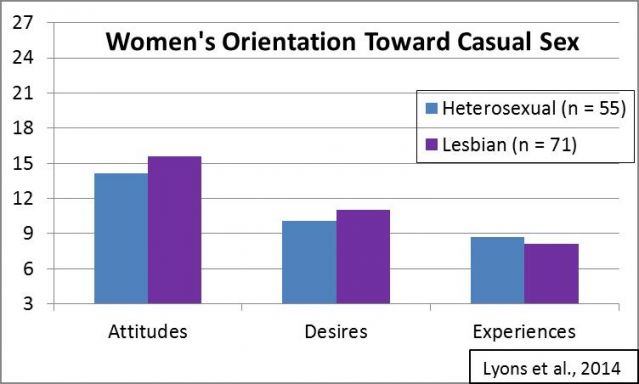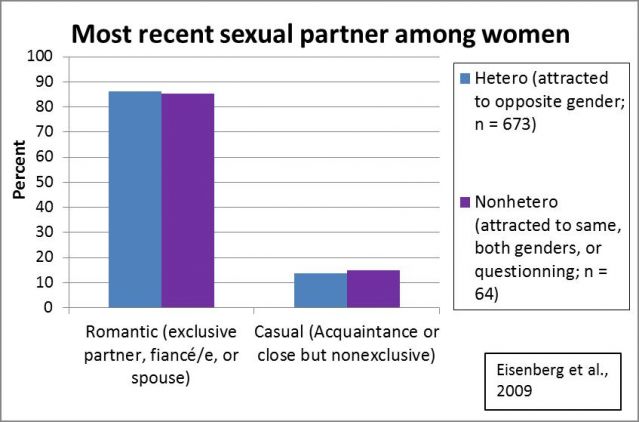Sex
Are Lesbians Less Into Casual Sex Than Hetero Women?
For women’s interest in hookups, sexual orientation doesn’t matter much.
Posted March 18, 2014

Everyone knows gay men like casual sex. But lesbians? Lesbians don’t hook up, they u-haul, right? The occasional lesbian may complain that other lesbians don’t do the ‘no strings attached’ thing, but it doesn’t seem like we’re getting a lesbian Grindr any time soon.
The invisibility of lesbian casual sex is not just a pop culture thing. Academic research on uncommitted sex among lesbian women is almost nonexistent too. Search PsycINFO (the most extensive psychology research database) for studies on heterosexual or gay male casual sex, and you’ll get about 100 articles for each. Search the same database for research on lesbian casual sex, and you’ll find a total of five such papers.
So are lesbians not at all into casual sex? Or are they similar to heterosexual women in their casual sex interests and experiences?
A recent study published in the Archives of Sexual Behavior provides a (partial) answer. Minna Lyons of Liverpool Hope University and her colleagues recruited 126 hetero and lesbian women (mean age = 27) from various online sources (discussion forums, social networking sites, and university students) for a study on ‘gaydar’. Among other things, participants were asked about three aspects of their orientation toward uncommitted sex (also known as sociosexuality in academic jargon):
- Desire for casual sex. Eg. “How often do you have fantasies about having sex with someone you are not in a committed romantic relationship with?” on a scale of 1 (Never) to 9 (At least once a day).
- Attitudes toward casual sex. Eg. “Sex without love is OK” on a scale of 1 (Strongly disagree) to 9 (Strongly agree).
- Experience with casual sex. Eg. “With how many different partners have you had sexual intercourse on one and only one occasion?” on a scale of 1 (Zero) to 9 (20 or more).
The graph below illustrates the means for the three components of sociosexuality for heterosexual and lesbian women (there were three questions for each component, so the possible range of the scale was from 3 to 27).

Two things are apparent from this graph.
1) Heterosexual and lesbian women did not differ on how much they desired, approved of, or had prior experiences with casual sex (none of the means were significantly different).
2) While women’s approval of casual sex was slightly above the mid-point of the scale, neither group was particularly desirous of or experienced with casual sex.
These findings replicate the results of an older study (from 1994) which also found virtually no differences between the casual sex proclivities of 140 heterosexual and lesbian women (aged 20-40) recruited using advertisements in a free urban (alternative) publication.
Finally, in a 2009 study, 946 young women (mean age = 20) were asked about the type of their most recent sexual partner. The women were recruited five years after they had participated in a study of Minnesota public high school students, and were therefore a fairly representative sample of the Minnesota young adult population.

As you can see, the percentage of women whose most recent sexual experience was with a casual acquaintance or a close but nonexclusive partner was almost identical for hetero and non-hetero women: 14% vs. 15%. (Granted, non-hetero in this study combined bisexual, lesbian, and questioning women, but it’s the only data of this kind we have.)
All in all, although sexual orientation matters for some aspects of female sexual psychology, casual sex is not one of them. Lesbians desire, approve of, and engage in hookups just as much (or as little) as heterosexual women do. Not more, not less.
And both groups of women show significantly less interest and acceptance of casual sex than either gay or heterosexual men. But that’s a story for a different post.
Have a casual sex story to share with the world? That's what The Casual Sex Project is for.
Follow me on Twitter @DrZhana for daily updates on the latest in sex research, check out my website for more information about me, or sign up for my monthly newsletter to stay up up to date with all my sex research- and sex education- related activities.
References:
Bailey, J. M., Gaulin, S., Agyei, Y., & Gladue, B. A. (1994). Effects of gender and sexual orientation on evolutionarily relevant aspects of human mating psychology. Journal of Personality and Social Psychology, 66, 1081-1093.
Eisenberg, M. E., Ackard, D. M., Resnick, M. D., & Neumark-Sztainer, D. (2009). Casual sex and psychological health among young adults: Is having “Friends with Benefits” emotionally damaging? Perspectives on Sexual and Reproductive Health, 41, 231-237. doi: 10.1363/4123109
Lyons, M., Lynch, A., Brewer, G., & Bruno, D. (2014). Detection of sexual orientation (“Gaydar”) by homosexual and heterosexual women. Archives of Sexual Behavior, 43, 345-352. doi: 10.1007/s10508-013-0144-7.




